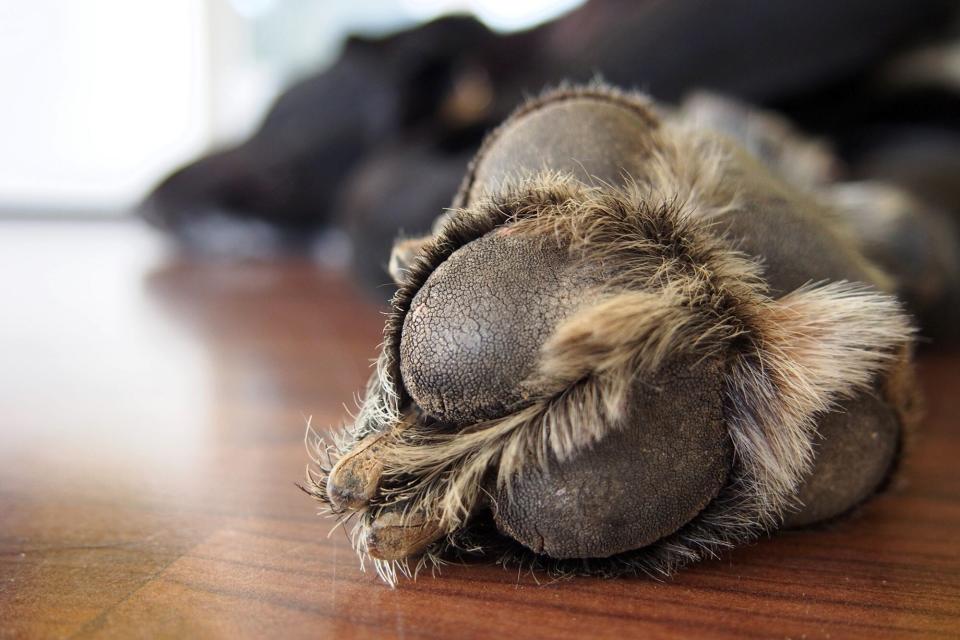How to Prevent Cracked Dog Paws and Protect Your Pup's Skin from Dryness
As a dog owner, the pitter patter of excited toes across the floor after a long day is likely music to your ears. Don't take this sound—or these moments—for granted. A dog's paws are critical to his overall health and well-being.
"Since dogs bear their full weight on their paw pads, maintaining healthy pads is vital to a happy and pain-free dog," says Angelica Dimock, DVM, managing shelter veterinarian at Animal Humane Society in Minn.
While wear and tear on your pup's paws is normal, dry cracked dog paws are a cause for concern. Be on the lookout for rough, uneven paws with cracks on the pads, often accompanied by abnormal behavior, including symptoms such as:
Limping
Avoiding rough surfaces
Lethargy
Isolation
What Causes Dry, Cracked Dog Paws?
Baby, it's cold outside. The weather is often a key contributor to the condition of your dog's paws.
"Poor pad health can be easily attributed to the surfaces the dog walks on," Dimock says. "In summertime, the hot sidewalks can burn off the outer protective layer of the pads. In the wintertime, the cold sidewalks can dry out pads leading to uneven layers and cracks."
RELATED: How Cold Is Too Cold for Dogs to Go Outside in Winter?
Ice melt salt and chemicals lining the sidewalks in winter may prevent you from taking a nasty spill, but they may cause your dog's paws to crack or sting. The ASPCA recommends carrying a towel on walks to wipe down prickly paws and giving them a full wash and dry once back home. Get into the routine of checking paw pads for cracks or redness after each walk."The easiest way to prevent injury to paw pads is to keep your dog on softer surfaces while outside, use booties, and limit time while outside in extreme weather," Dimock says.

vendulak / Adobe Stock
Cracked Dog Paw Pad Treatment and Home Remedies
If, despite your best efforts, your poor pooch's paws remain problematic, try taking matters into your own hands. Coconut oil can help soothe cracked dog paws, Dimock says, as can Vitamin E oil. For an "over-the-counter" topical paw balm solution, Dimock recommends Bag Balm. Apply a thin layer to the affected areas and make sure your dog does not lick the product off.
According to the American Veterinary Medical Association, wax-based petroleum and lanolin products may be applied to your dog's paws before heading outdoors to protect from cold and ice.
When in doubt, your veterinarian is your best resource. Ask if they can recommend a product best suited to your dog's paw pad health.
When to See a Vet
Don't allow cracked dog paws to go untreated. Consistent at-home care may not always be the solution. "If left untreated, cracked paws will lead to pain, lameness, and infection," Dimock says. "Bring your dog in if you notice any lameness, constant licking or chewing, and/or changes in pad appearance."
In rare instances, your dog's cracked paws may be a symptom of an underlying health condition, such as an autoimmune disorder, previous exposure to canine distemper virus, or a skin disease, such as hyperkeratosis. Hyperkeratosis is characterized by rough, hairy pads, Dimock says, though this condition is not always painful to dogs and might not present as an issue. Your vet can run diagnostic tests if you suspect an underlying condition.
If your pet is exposed to extreme temperatures and has burns or frostbite on their paw pads, consult with your vet about the best way to treat the wounds. Superficial pad injuries may take a couple weeks to heal, Dimock says, but deep burns or frostbite can take around a month to recover.

